Scientific research often begins with a mystery – something in the data that makes the researchers think – Huh? That’s funny.
In this issue of
Wader Study, authors Lindström and Alerstam begin their
paper1 with just such a mystery. The researchers studied the 5,000–7,000 km non-stop flights that Great Snipes
Gallinago media make during migration from central Sweden to equatorial Africa (and back). To do this, they attached tiny sensors (called mini-multisensory accelerometers) to the bird’s lower leg (tibia). These sensors that weigh less than two grams and measure ambient temperature and pressure every hour and movement every five minutes
2.
[caption id="attachment_14028" align="alignnone" width="700"]
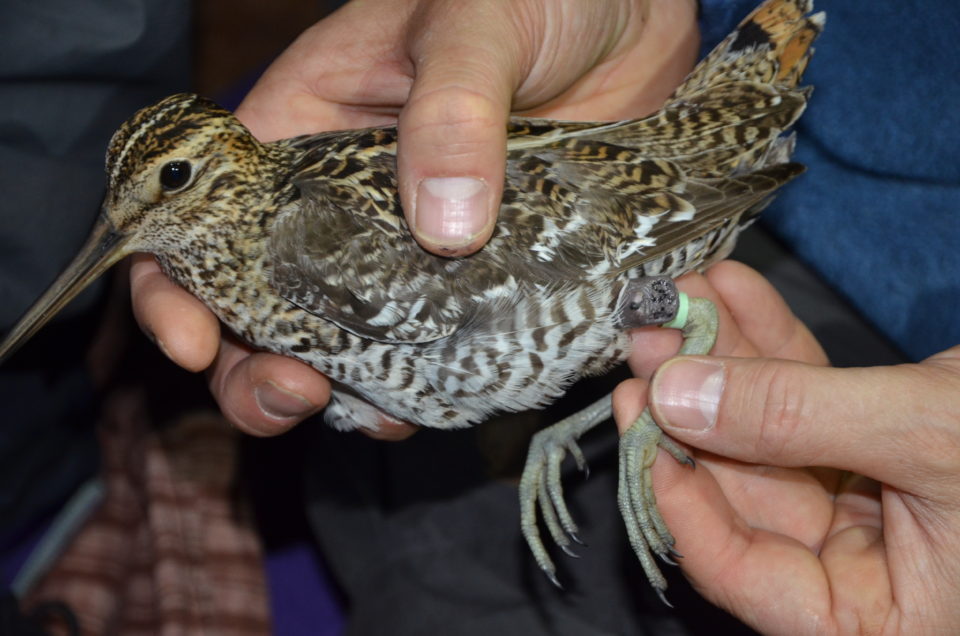
Great Snipe outfitted with a mini-multisensory accelerometer on the tibia. (photo: Åke Lindström)[/caption]
The ability to collect data at this level of detail from high flying birds (literally migrating at cruising altitudes above 4000 m) is astounding. However, the researchers found themselves struggling to interpret some of the data. In several of the 15 flights studied, there were periods when activity suddenly stopped, and temperature rose. It looked like the bird had landed, but air pressure remained low suggesting the bird was still at high altitude. Then, usually in under an hour, activity was high again and temperature low. It was a mystery. After ensuring that the data were not due to a technical malfunction, the researchers started to ponder other explanations.
As previously mentioned, the sensor sits on the bird’s lower leg. Unlike birds that perch (Passerines), which tend to fly with legs tucked up against the body, most shorebirds fly with their legs stretched out under the tail. Maybe the unusual sensor data showed that the birds had folded their legs and tucked them under the belly feathers? This would explain the abrupt rise in temperature and even the decrease in activity, due to the angle at which the accelerometers measure movement.
This was a plausible hypothesis and it generated more questions: How common is it for shorebirds fold to their legs when flying? Which species do it? Are Great Snipes one of the species that do it? Then, delving even deeper into the mystery,
why would the birds fly with folded legs? A literature search revealed very few studies on the topic. The researchers had their work cut out for them.
At this point, you might be asking why does this matter? Knowledge about the way shorebirds hold their legs when flying is not something to be immediately marketed. The scientists were simply curious. It is an example of fundamental research. There is no immediate application, but who knows where it could lead? Time and again it leads to later innovations, and it often starts with a mystery.
To try to solve their mystery, the researchers first put out a call for information over email and social media. They asked for photos and observations of shorebirds flying with their legs folded and any available information about species, location, date, and time. They examined online photos of flying shorebirds from the Swedish Species Observation System (
www.artportalen.se). After checking nearly 10,000 photos, they found just over 1,300 that were sharp enough to determine leg position.
The data in this study were gathered mainly online. Working primarily online is something many of us have been doing since the start of the current pandemic (in the best-case scenario). Scientists have lost field seasons, experiments, even jobs. Though conducted before the pandemic, this study shows that research can go on, in some capacity, using data that are already available online.
[caption id="attachment_14029" align="alignnone" width="700"]
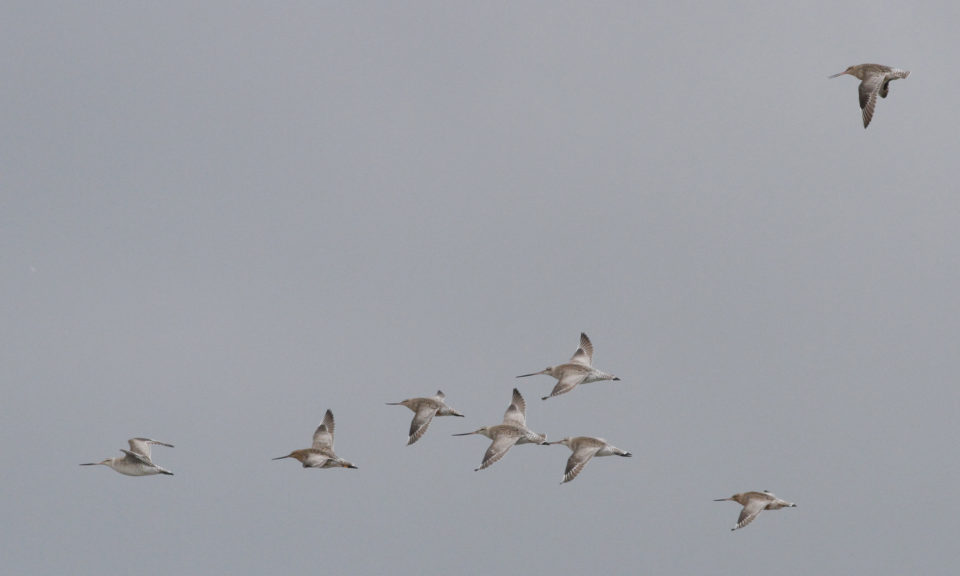
Bar-tailed Godwits flying with legs folded (the one on the upper right) and outstretched. (photo: Jesse Conklin)[/caption]
The researchers’ call for information produced reports of 17 species flying with folded legs. The behavior was most common in the long-legged Spotted and Common Redshank species
Tringa erythropus and
Tringa totanus. Reports came from Canada, the USA, New Zealand and five countries in Europe, suggesting that flying with legs folded is not restricted to a particular latitude or longitude. However, the authors acknowledge that it is not the complete story because they lacked feedback from large parts of the world and therefore data on many shorebird species.
The 1,300 plus database photos with detectable leg position revealed at least 31 birds flying with folded legs. This more quantitative data allowed the researchers to estimate how often this behaviour occurs within a species. In Spotted Redshanks, about 11% of the photos had birds flying with legs tucked. Rates of over 1% were detected in Greenshanks
Tringa nebularia, Ruffs
Calidris pugnax and Common Snipe
Gallinago gallinago.
All of the information together showed that shorebirds fly with legs folded in most months of the year, in different age classes, alone and in flocks, and in both migratory flights and local movements. So, why do they do it? Perhaps to decrease heat loss in cold temperatures. A similar strategy is used when birds rest standing on one foot and tuck the other into the belly feathers (unipedal roosting). Earlier research has shown that the likelihood of unipedal roosting increases with decreasing temperature
3. The colder it is, the more birds stand on one leg when resting. Thermoregulation is clearly one reason to fly with legs folded, but this can’t be the only reason because birds also fly with legs folded when the ambient temperature is mild.
Might leg position affect flight performance? Folding the legs below the body moves the centre of gravity forwards. Whether this is a help or a hinderance might depend on how much fuel the bird is carrying. During migration, shorebirds can carry anything from no fuel stores to more than doubling their body mass with stored fat and protein. This fuel is mainly stored behind the centre of gravity, thus folding the legs could potentially balance stored fuel. Since birds carry different fuel loads, this might explain why both leg positions are found in flocks where birds are experiencing the same ambient temperatures.
Could muscle fatigue be another explanation? Keeping the feet trailing during long flights is tiring. To cope, shorebirds have fatigue-resistant slow tonic and twitch fibres in their leg muscles, whereas perching bird species, which tend to fly with legs tucked, have a lower proportion of such slow fibres
4. Based on muscle anatomy, it should be easier for birds that normally fly with extended legs to sometimes fly with folded legs (as seen in shorebirds) rather than the other way around. This idea remains to be tested.
Now returning to the mystery, what about Great Snipes, do they fly with legs folded? Unfortunately, the authors found no evidence of this. However, Great Snipes are rarely seen and when they are seen, it is difficult to see leg posture in flight. The authors did find the behaviour in many other species, including the Common Snipe, a close relative to the Great Snipe. They therefore conclude that flying with folded legs may well occur in Great Snipes, but proof remains to be found.
Although the authors did not entirely solve their mystery, they gathered a lot of previously unknown information. Their study indicates shorebirds do sometimes fly with folded legs and that reducing heat loss at low temperatures is a likely reason for this behaviour, but not the only one. Aerodynamics and leg muscle fatigue may also play a role. The research generated both new knowledge and further questions.
This is the essence of fundamental research, which often lays the foundations for innovation. Examples abound, but here is a bird-related one. In the 1970s, researchers were studying retroviruses in chickens. When they found something puzzling, and started searching for answers, they were not looking to revolutionize the field of cancer genetics. Yet their discovery that the cancer-causing genes – oncogenes – in chicken retroviruses were actually derived from the host genome was a breakthrough. Oncogenes were now relevant for all animals, including humans. Later, researchers studying oncogenes in humans encountered a particular gene – HER2 – that was associated with aggressive forms of breast cancer. This gene became the target of research that eventually led to drugs like Herceptin for breast cancer and Gleevec for chronic myelogenous leukemia. For decades, different teams of researchers found mysteries and built upon the work of others to solve them. The culmination of all of these projects – which began with research on retroviruses in chickens
5 – gave us life-saving drugs.
Especially in our current era with so many pressing problems to solve, it is important to remember that the best way to fuel innovation is to support fundamental research.
Stay curious.
PDF is available for download here:
https://www.waderstudygroup.org/article/13808/
- Lindström, A & T. Alerstam. 2020. Waders flying with folded legs – which species, when, where and why? Wader Study 127(2): 113-120.
- Bäckman, J., A. Andersson, L. Pedersen, S. Sjöberg, A. P. Tøttrup & T. Alerstam. 2017. Actogram analysis of free-flying migratory birds: new perspectives based on acceleration logging Journal of Comparative Physiology A203: 543–564. https://doi.org/10.1007/s00359-017-1165-9
- Ryeland, J., M.A. Weston & M.R.E. Symonds. 2019. Leg length and temperature determine the use of unipedal roosting in birds. Journal of Avian Biology 50(5): e02008. https://doi.org/10.1111/jav.020
- Walker, A.M. & R.A. Meyers. 2019. The anatomy and histochemistry of flight hindlimb posture in birds. II. The flexed hindlimb posture of perching birds. Journal of Anatomy 234: 668–678.
- Sawyers, C. L. 2019. Herceptin: A First Assault on Oncogenes that Launched a Revolution. Cell 179: 8-12. https://doi.org/10.1016/j.cell.2019.08.027
Posted by Deborah Buehler on 15 August 2020
Scientific research often begins with a mystery – something in the data that makes the researchers think – Huh? That’s funny. In this issue of Wader Study, authors Lindström and Alerstam begin their paper1 with just such a mystery. The researchers studied the 5,000–7,000 km non-stop flights that Great Snipes Gallinago media make during migration from central Sweden to equatorial Africa (and back). To do this, they attached tiny sensors (called mini-multisensory accelerometers) to the
Posted by Gwenaël Quaintenne on 17 July 2020
At the end of August, Jen and Mark Smart will completed a 8-day fundraising cycling ride over a distance of 600 miles to support Project Godwit and IWSG small grants: They will be wearing special IWSG 50th anniversary cycling jerseys. Want one? You can purchase it now and until the 27th Jully by sending an email to Jennifer.smart@rspb.org.uk or contact Jen via direct message on Twitter @drredshank: https://twitter.com/drredshank/status/1283506019755327489?s=20 Follow their route and support
Given the current circumstances around Covid-19, we have decided to postpone our anniversary conference on the island of Sylt, Germany to 8-11th October 2021.
Postponing the Sylt conference does not mean we should skip a year of sharing knowledge and meeting each other, as so we invite you to join our:
Virtual annual conference on 10-11th October 2020.
Following other ornithological events, we will be using Zoom Webinar to host the meeting.
Registration and abstract submission for the conference will open on 15th June, by which time detailed information about the meeting will be found at
www.waderstudygroup.org/conferences/2020-virtual-conference.
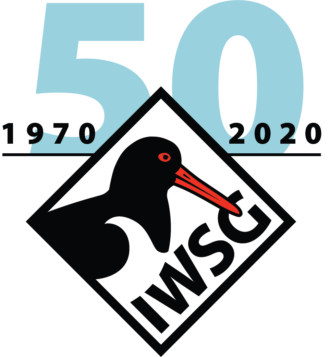
Posted by Gwenaël Quaintenne on 2 June 2020
Given the current circumstances around Covid-19, we have decided to postpone our anniversary conference on the island of Sylt, Germany to 8-11th October 2021. Postponing the Sylt conference does not mean we should skip a year of sharing knowledge and meeting each other, as so we invite you to join our: Virtual annual conference on 10-11th October 2020. Following other ornithological events, we will be using Zoom Webinar to host the meeting. Registration and abstract submission for the conference
IWSG are happy to announce that we have found the successful applicant for the 2019 Small Project Grant:
Emmanuel Nii Attram Taye from the
University of Ghana with his project "
Breeding ecology and foraging behaviour of Black-winged stilts in Ghana".
Aspects of Black-winged stilt (
Himantopus himantopus) foraging and breeding biology is still poorly understood. The project will investigate behaviour and nesting success of this species in the Densu Delta Ramsar Site in Ghana. The project will be the first to report on the interactions - such as interference and predation - between Black-winged stilts and Little tern (
Sternula albifrons) with which is shares breeding habitat.
The data is thought to be of high value for making wetland conservation decisions, in Ghana and beyond.
The committee were happy with the project's focus on African waders. Breeding biology and requirements of many African waders is unknown and this study will definitely add to new knowledge.
Congratulations to Emmanuel!
[caption id="attachment_13630" align="aligncenter" width="567"]

The 2020 IWSG Small Grant will support the project proposal of Emmanuel Nii Attram Taye from the University of Ghana about the behaviour and nesting success of Black-winged stilts in the Densu Delta Ramsar Site in Ghana. ©E. Taye.[/caption]
The Small Project Grant committee would like to thank all who applied for the grant. We were very happy with the high standard of the projects applied for! Thank you all.
Also, please consider applying for the next application round. Announcement of the opening of the call will come via the IWSG website and social media.
Jannik Hansen
on behalf of the Small Project Grant committee
Featured image: Black-winged Stilt, Somme Bay, July 2018, ©Bigayon.
Posted by Gwenaël Quaintenne on 27 April 2020
IWSG are happy to announce that we have found the successful applicant for the 2019 Small Project Grant: Emmanuel Nii Attram Taye from the University of Ghana with his project "Breeding ecology and foraging behaviour of Black-winged stilts in Ghana". Aspects of Black-winged stilt (Himantopus himantopus) foraging and breeding biology is still poorly understood. The project will investigate behaviour and nesting success of this species in the Densu Delta Ramsar Site in Ghana. The project will be
News authored by Vojtěch Kubelka and Tamás Székely
Within the ÉLVONAL Shorebird Science project:
Sex role evolution: testing the impacts of ecology, demography and genes, we are trying to understand the fundamental associations among key components of sex roles: courtship, pair bonding, incubation and parental care, investigating shorebirds across continents. We have established cooperation among 28 teams worldwide working with 46 populations of 31 shorebird species and currently we are offering various volunteering fieldwork experience in Belarus, Cape Verde, Russia, Thailand or Tunisia as well as a new post-doc position within the project.
Find out more at:
https://elvonalshorebirds.com/contact/
or contact Vojtěch Kubelka
kubelkav(@)gmail.com
[caption id="attachment_13492" align="aligncenter" width="330"]
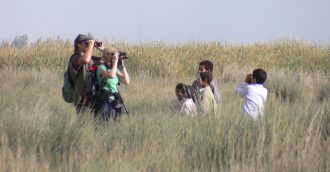
Fieldwork in Africa can be difficult for researchers working with shorebirds, but an engagement with local communities is worth of the investment and represents a key to the successful conservation measures, photo: Vojtěch Kubelka.[/caption]
Featured image: Adult Shore Plover (
Thinornis novaeseelandiae), monitored in detail at Motutapu Island, New Zealand, photo: Vojtěch Kubelka.
Posted by Gwenaël Quaintenne on 25 February 2020
News authored by Vojtěch Kubelka and Tamás Székely Within the ÉLVONAL Shorebird Science project: Sex role evolution: testing the impacts of ecology, demography and genes, we are trying to understand the fundamental associations among key components of sex roles: courtship, pair bonding, incubation and parental care, investigating shorebirds across continents. We have established cooperation among 28 teams worldwide working with 46 populations of 31 shorebird species and currently we are
Initiated following a workshop during the 2017 International Wader Study Group conference in Prague, a new online resource for the conservation of Northern Lapwings hosted by NABU/Birdlife Germany & its partners has been launched at: https://lapwingconservation.org.
The platform is adressed to scientists, conservationists as well as farmers and other stakeholders involved in the conservation of Northern Lapwings (
Vanellus vanellus). It aims at giving both the necessary background information as well as practical advice for a better protection of the species in Europe. New contents and updates will be available on a regular basis.
In the
„Case studies“ section some contents were published in English already.
LAPWINGCONSERVATION.ORG will become increasingly international with the development of english ressources and pages.
LAPWINGCONSERVATION.ORG is hosted by NABU/Birdlife Germany as part of the Lapwing project „Sympathieträger Kiebitz“ within the national programme on biodiversity in Germany. Many European partner organisations and institutions will be involved in the multilingual development of the platform.
Additionally,
a Twitter account has been launched for the project: @Lapwingconserv
Visit the website
LAPWINGCONSERVATION.ORG:
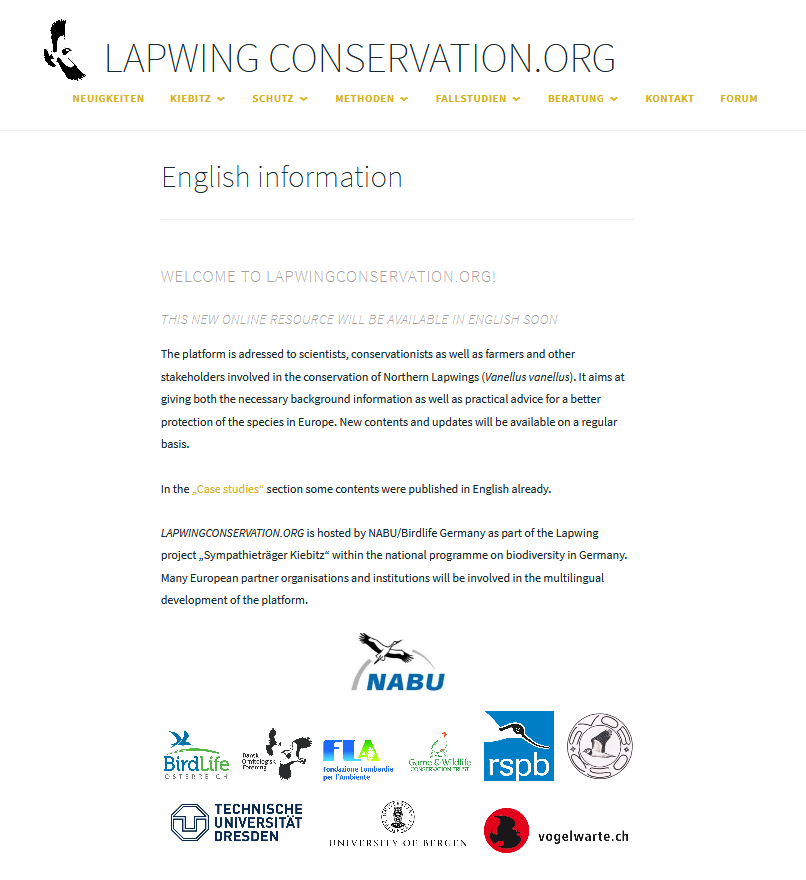
Posted by Gwenaël Quaintenne on 24 February 2020
Initiated following a workshop during the 2017 International Wader Study Group conference in Prague, a new online resource for the conservation of Northern Lapwings hosted by NABU/Birdlife Germany & its partners has been launched at: https://lapwingconservation.org. The platform is adressed to scientists, conservationists as well as farmers and other stakeholders involved in the conservation of Northern Lapwings (Vanellus vanellus). It aims at giving both the necessary background information
ANNOUNCING
#ISTC20 – 7 – 8 October 2020
We’re thrilled to be teaming up with the British Ornithologists’ Union (BOU) to jointly host the first ever
International Shorebird Twitter Conference 2020, an online global event as part of the IWSG’s 50
th anniversary and ahead of our annual conference on 10-11 October 2020.
.

Twitter conferences are proving increasingly popular as a low carbon, cost-free and inclusive way for researchers from around the world to come together to share their research. Anyone can take part! From wherever you want! You can present and follow from your desk, sofa or on your commute!
The BOU are leaders in social media communication in ornithology, having previously hosted two successful general ornithology Twitter conferences and are sponsors of the World Seabird Twitter Conferences (#WSTC6 is in May).
For full details and abstract submission see :
https://www.bou.org.uk/conference/istc20/
Featured image: Ingrid Tayler / Shorebird Nation CC BY 2.0 Wikimedia Commmons
Posted by Gwenaël Quaintenne on 20 February 2020
ANNOUNCING #ISTC20 – 7 – 8 October 2020 We’re thrilled to be teaming up with the British Ornithologists’ Union (BOU) to jointly host the first ever International Shorebird Twitter Conference 2020, an online global event as part of the IWSG’s 50th anniversary and ahead of our annual conference on 10-11 October 2020. . Twitter conferences are proving increasingly popular as a low carbon, cost-free and inclusive way for researchers from around the world to come together to share their
From
Sampath Seneviratne Avian Evolution Node/Univ. of Colombo.
Mannar wetlands
Mannar Island is located in the arid northwestern coast of Sri Lanka, bordering the southern edge of the sensitive Palk Bay Marine ecosystem. Almost a million waterbirds spend the winter every year in Mannar’s wetlands, which consists of tidal mudflats, salt marshes, shallow lagoons with mangrove forests, salt pans, freshwater marshes and lakes. Mannar covers about 200 sqkm in area, and projects northwesterly from mainland Sri Lanka to the Rama’s bridge/ Adam’s Bridge – a chain of sandy islands where large numbers of terns breed annually. Mannar is a migratory gateway which funnels the high and sub-arctic breeders to Sri Lanka. Sri Lanka is the southernmost tip of the Central Asian Flyway (CAF).
[caption id="attachment_13414" align="aligncenter" width="330"]
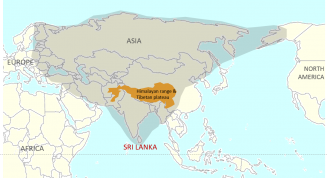
Sri Lanka is located at the at the southern edge of the Central Asian Flyway.[/caption]
Mannar is undergoing a rapid change. Its wetlands are being encroached and utilized for carelessly planned development activities. A new development scheme of ADB funded wind turbines is coming up – a series of windmills are being erected along the western coast of the island and the associated power lines move right across the Vankalei mudflats - the largest wintering ground in Mannar – which is also a Ramsar site. This was the same site where one individual of the extremely threatened
Spoon-billed Sandpiper was recorded in June 2018. Furthermore, the one and only freshwater lake that is found within Mannar island, the Korakulum lake is threatened due to illegal encroachment. Korakulum, lacking any kind of protection at the moment is among the most preferred foraging grounds of the migrant ducks which easily exceed 6000 individuals at any given time. And the sandy islands of Rama’s Bridge where close to 10,000 individuals of nationally endangered seabirds breed every year are roamed by feral dogs – causing devastating effects on the colonies of these ground-nesters.
[caption id="attachment_13416" align="aligncenter" width="330"]
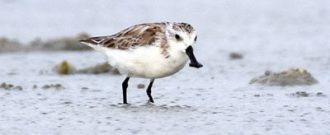
Spoon-billed Sandpiper at Vankalai Sanctuary in Mannar, Sri Lanka, on 06 June 2018. Darshana, T. W. R., 2018.
Rediscovery of the Spoon-billed Sandpiper Calidris pygmaea in Sri Lanka after 40 years. Indian BIRDS. 14 (4): 111–112. © Ravi Darshana.[/caption]
Great Knot F132608 H29 was banded on April 22nd 2014 in Chongming Dongtan, Shanghai, China as an adult
The Great Knot is a rare migrant to Sri Lanka. However it is an uncommon and a regular visitor to Mannar. Among these regular flocks of Great Knots, last week, a photographer named Debunkur Biswas, had captured a flagged bird. Black over White H29. Tracing back to its origin by contacting Russian and Chinese teams, we were told by Wu Wei (Chongming Dongtan National Nature Reserve, Chongming, Shanghai) that it was banded on April 22nd 2014 in Chongming Dongtan, Shanghai, China as an adult.
.
[caption id="attachment_13413" align="aligncenter" width="330"]
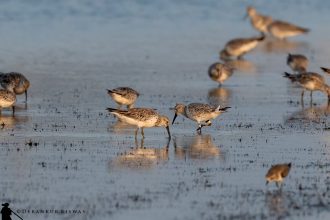
H29 Great Knot photographed by Debunkur Biswas, last week in Mannar. The bird was banded on April 22nd 2014 in Chongming Dongtan, Shanghai, China as an adult. © Debunkur Biswas.[/caption]
The Field Ornithology Group of Sri Lanka (FOGSL), which is the BirdLife partner in Sri Lanka is a conservation organization located at the Department of Zoology, University of Colombo, Sri Lanka. FOGSL runs the National Bird Ringing Programme for Sri Lanka in collaboration with the Department of Wildlife Conservation. FOGSL as part of their banding programme has a research project on shorebird migration in Mannar. We have a banding station and a local field station where graduate students, wildlife officers and general public band and study shorebirds.
So far, we produced 04 banded Great Knots from Mannar. The first 03 birds which were banded in January 2019 were resighted every month since then, till June 2019. They were regularly seen in a flock of ~20 birds. Resightings were made again in October 2019 when a flock of 75 individuals appeared back to the same mudflat. We are planning to deploy GPS tags on some of these birds in the spring before they head north for breeding to track their exact migratory paths and to map the boundary of CAF, from a Sri Lanka standpoint.
Sampath Seneviratne PhD
Research Scientist - Molecular Ecology | Evolution | Ornithology
Department of Zoology & Environment Sciences,
University of Colombo
Website: Avian Evolution Node:
http://evolution.cmb.ac.lk/
https://www.researchgate.net/profile/Sampath_Seneviratne
Posted by Gwenaël Quaintenne on 18 February 2020
From Sampath Seneviratne Avian Evolution Node/Univ. of Colombo. Mannar wetlands Mannar Island is located in the arid northwestern coast of Sri Lanka, bordering the southern edge of the sensitive Palk Bay Marine ecosystem. Almost a million waterbirds spend the winter every year in Mannar’s wetlands, which consists of tidal mudflats, salt marshes, shallow lagoons with mangrove forests, salt pans, freshwater marshes and lakes. Mannar covers about 200 sqkm in area, and projects
A housing development on a large area of open countryside close to Langstone Harbour is threatened major wintering habitats of Eurasian Curlew and Brent Geese. In this area the birds feed on wet grassland, identified as core habitat in the
Solent Waders and Brent Goose Strategy.
[caption id="attachment_13375" align="aligncenter" width="330"]

Site location of the Campdown proposed development (top) is identified in the
Solent Wader & Brent Goose Strategy as a core site (bottom).[/caption]

Up to 350 Brent Geese and 150 Curlew feed on these wet grassland in the winter, returning to roost in Langstone Harbour each evening.
Peter Potts, a long-time IWSG member, is actively fighting against this housing development project, presenting arguments motived by his many years of experience on surveying waders in the Solent estuary area. See the detailed objection of Pete there:
Camp Down planning application response Jan 2020.pdf
The International Wader Study Group wrote to the Havant Borough Council to express its concern over the proposed development at the Land East of College Road, Campdown, Purbrook, Waterlookville.
IWSG_Letter of support re Langstone Harbour SPA_Havant Borough Council_2020Jan22.pdf
British people are encouraged to leave their comments and object to the APP/19/01101 project on the Havant Borough Council website by the deadline of 13th February 2020, at (simply copy & paste APP/19/01101 in the search box): https://planningpublicaccess.havant.gov.uk/online-applications/
Posted by Gwenaël Quaintenne on 23 January 2020
A housing development on a large area of open countryside close to Langstone Harbour is threatened major wintering habitats of Eurasian Curlew and Brent Geese. In this area the birds feed on wet grassland, identified as core habitat in the Solent Waders and Brent Goose Strategy. Up to 350 Brent Geese and 150 Curlew feed on these wet grassland in the winter, returning to roost in Langstone Harbour each evening. Peter Potts, a long-time IWSG member, is actively fighting against this
Lice.
Probably not the first thing that comes to mind when thinking about shorebirds.
Yet, avian parasites – like hitch-hiking lice – can play a major role in shorebird life. Their effects can range from mere annoyance to a selective force strong enough to impact the behaviour, ecology, life history and perhaps even migration strategies of their hosts
1,2. Though these parasites have been studied for some time, we’ve barely scratched the surface in terms of understanding which species of louse live on which species of shorebird and how these patterns might vary geographically. Thus, much of the work to be done involves simply describing what is there.
Two studies published in this
issue of
Wader Study endeavour to do just that. Gustafsson and colleagues from China redescribe two species of chewing lice collected from seven Grey-headed Lapwings
Vanellus cinereus caught in Jinshanyakou, China
3. Tavera and colleagues from Canada and Perú delve into the occurrence and diversity of chewing lice on shorebirds in Paracas, Perú
4.
For many people, just thinking about lice makes their heads itch. For shorebirds, chewing lice Phthiraptera live in the feathers rather than the hair, but like human head lice, they are obligate ectoparasites. They have no wings and they use biting (not sucking) mouthparts to feed on feathers, blood and dead skin. In order to live, they must hitch a ride with a bird.
Anyone who has ever done a louse check on a child (or themselves) knows that lice are not always easy to see and definitely not easy to remove. So how did the researchers go about studying bird lice?
The first step was catching the birds. In both studies, the researchers used mist nets at night. Gustafsson and colleagues set their nets up in a mountain range in September 2018 at Jinshanyakou in China.
[caption id="attachment_13361" align="alignnone" width="700"]

View from the Jinshanyakou Field Station over the mountain ranges of South Yunnan (photo: D.R. Gustafsson).[/caption]
On the other side of the world, and at sea level, Tavera and colleagues set up mist nets on the Pacific coast at the Paracas National Reserve, Perú. They caught birds in September 2017, January 2018 and March 2018 – across seasons – because they wanted to document seasonal patterns of louse abundance.
[caption id="attachment_13360" align="alignnone" width="700"]
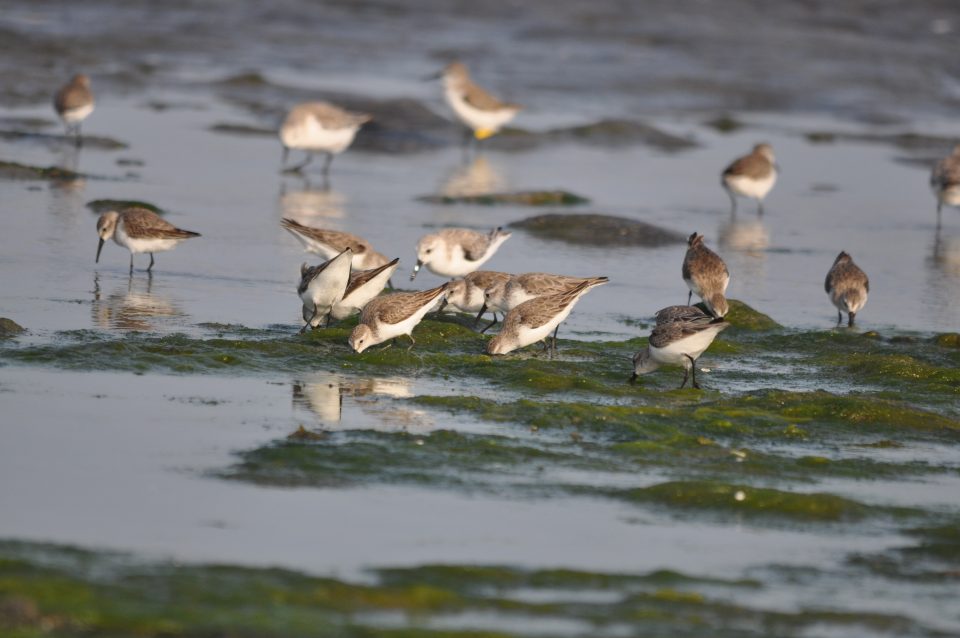
Sanderlings, Western and Semipalmated Sandpipers foraging in Paracas, Perú (photo: E.A. Tavera).[/caption]
The second step was finding and then capturing the lice. In both studies, louse checks were performed immediately after the birds were caught. This is because lice can escape. Some of us have held birds and had their lice crawl right onto us. Of course, finding the lice isn’t always that easy. One way to get to them is to gas them out. Gustafsson and colleagues started with this approach. They placed the birds in bags (with their heads safely uncovered) and fumigated the feathers with ethyl acetate. This got some of the lice, but some remained hidden in the thick plumage. So, the researchers also manually searched for lice on the wings, back, rump, flanks, neck and head, using forceps to lift the feathers. Tavera and colleagues used only manual searching. They also ensured that the same observer examined body and flight feathers from all birds for a set time of 2–3 min. This minimized variation in sampling effort and technique. Once removed from the birds, the lice were stored in ethanol to be taken to the lab.
The final step was identifying what species of louse had been found. In both studies, the researchers first had to prepare the specimens. They used 20% potassium hydroxide (KOH), which softens, digests and clears the tissues, making identification easier. Then they dehydrated the specimens using increasingly stronger solutions of ethanol. Finally, they mounted each specimen on a slide and let it dry further. Only then could the researchers truly examine specimens under a light microscope and use taxonomic keys to identify the lice based on morphology.
Using these careful methods, Gustafsson and colleagues sampled a total of seven Grey-headed Lapwings. Of these, four birds were parasitized by
Actornithophilus hoplopteri (nine males, ten females, eight nymphs), and one bird was parasitized by
Quadraceps sinensis (six males, three females). The only bird parasitized by
Q. sinensis was also parasitized by
A. hoplopteri. The samples size is small because the lapwings were caught as part of a larger study on chewing lice in a number of non-shorebird species
5. However, only a small sample was needed to achieve the authors’ goal to comprehensively redescribe both the males and females of the two species found. This will provide shorebird researchers with better identification tools to study bird lice in the future.
Tavera and colleagues caught and sampled 108 individuals of seven shorebird species and collected 160 individual lice. The lice were of the Menoponidae and Philopteridae families and the authors were further able to classify them into four genera and nine species. All of the species reported were new geographical records for shorebirds in Perú.
Tavera and colleagues found that lice were most prevalent on Ruddy Turnstones
Arenaria interpres and Sanderlings
Calidris alba, with 80% of birds parasitized. Western Sandpipers
C. mauri were the least parasitized species, with 36% parasitized. Sanderlings hosted the highest abundance of lice, while Semipalmated Sandpipers
C. pusilla had the highest species richness hosting four different species of louse.
The authors were interested in whether louse infestations negatively affected body condition, but they found no significant relationship between body condition and total parasites. Infested (or more infested) birds did not seem to have decreased body condition. So just how important are chewing lice in Perú? This study suggests that they may be a mere annoyance at the levels of infestation found.
In terms of seasonality, Tavera and colleagues saw a decreasing trend of parasite number per individual through the nonbreeding season. Although not statistically significant, the trend might indicate that individuals are losing ectoparasites during their stay at Paracas. But why? The authors speculated that the apparent decrease might indicate that habitat in Perú is ‘cleaner’ than the birds’ more northerly stopovers. This would be consistent with the hypothesis that long distance migrating shorebirds might have lower immunocompetence and thus need to use lower parasite marine habitats whenever possible
2. However, the apparent reduction of ectoparasite numbers could also indicate that more parasitized birds are leaving the population by emigration or death. A third explanation could be seasonality of the adult versus egg/larval life stages in the lice. Finally, body molt could be a potential reason for reducing a load of ectoparasites, especially in cases where the molt began at arrival to the non-breeding areas.
These two papers contribute to a growing body of knowledge about ectoparasites and their occurrence and effects on birds. Not everyone finds this fascinating, but we need only to look to studies of our own parasites to see the potential
6. Humans have been infested by lice for millions of years. Like in birds, human louse infestations can mean everything from annoyance to death. Human body lice can transmit at least three intracellular pathogenic bacteria causing epidemic typhus, relapsing fever, and trench fever. They also have a global distribution – probably because they hitched rides with us as we colonized the globe – and so they can be good markers for studying human evolution.
Lice. Maybe more interesting than you might have thought.
PDF is available for download here:
https://www.waderstudygroup.org/article/13213/
1Hicks, O., S.J. Burthe, F. Daunt, M. Newell, A. Butler, M. Ito, K. Sato & J.A. Green. 2018.
The energetic cost of parasitism in a wild population.
Proceedings of the Royal Society B 285: 20180489
.
2Piersma, T. 1997.
Do global patterns of habitat use and migration strategies co-evolve with relative investments in immunocompetence due to spatial variation in parasite
pressure? Oikos 80: 623–631.
3Gustafsson, D.R., L. Lujia, C. Xingzhi, Z. Xuebing & Z. Zou. 2019.
Chewing lice (Phthiraptera) of the Grey-headed Lapwing, Vanellus cinereus, in China.
Wader Study 126: 217-227.
4Tavera, E.A., D. Minaya, E. Ortiz Lopez, J. Iannacone & D.B. Lank. 2019.
Chewing lice richness and occurrence in non-breeding shorebirds in Paracas, Perú.
Wader Study 126: 190–199.
5Gustafsson, D.R., L. Lei, K. Luo, X. Chu, X. Zhao, Q. Zhang & F. Zou. 2019.
Chewing lice from high-altitude and migrating birds in Yunnan, China, with descriptions of two new species of Guimaraesiella.
Medical & Veterinary Entomology 33: 407–419.
Posted by Deborah Buehler on 24 December 2019
Lice. Probably not the first thing that comes to mind when thinking about shorebirds. Yet, avian parasites – like hitch-hiking lice – can play a major role in shorebird life. Their effects can range from mere annoyance to a selective force strong enough to impact the behaviour, ecology, life history and perhaps even migration strategies of their hosts1,2. Though these parasites have been studied for some time, we’ve barely scratched the surface in terms of understanding which species of

 Great Snipe outfitted with a mini-multisensory accelerometer on the tibia. (photo: Åke Lindström)[/caption]
The ability to collect data at this level of detail from high flying birds (literally migrating at cruising altitudes above 4000 m) is astounding. However, the researchers found themselves struggling to interpret some of the data. In several of the 15 flights studied, there were periods when activity suddenly stopped, and temperature rose. It looked like the bird had landed, but air pressure remained low suggesting the bird was still at high altitude. Then, usually in under an hour, activity was high again and temperature low. It was a mystery. After ensuring that the data were not due to a technical malfunction, the researchers started to ponder other explanations.
As previously mentioned, the sensor sits on the bird’s lower leg. Unlike birds that perch (Passerines), which tend to fly with legs tucked up against the body, most shorebirds fly with their legs stretched out under the tail. Maybe the unusual sensor data showed that the birds had folded their legs and tucked them under the belly feathers? This would explain the abrupt rise in temperature and even the decrease in activity, due to the angle at which the accelerometers measure movement.
This was a plausible hypothesis and it generated more questions: How common is it for shorebirds fold to their legs when flying? Which species do it? Are Great Snipes one of the species that do it? Then, delving even deeper into the mystery, why would the birds fly with folded legs? A literature search revealed very few studies on the topic. The researchers had their work cut out for them.
At this point, you might be asking why does this matter? Knowledge about the way shorebirds hold their legs when flying is not something to be immediately marketed. The scientists were simply curious. It is an example of fundamental research. There is no immediate application, but who knows where it could lead? Time and again it leads to later innovations, and it often starts with a mystery.
To try to solve their mystery, the researchers first put out a call for information over email and social media. They asked for photos and observations of shorebirds flying with their legs folded and any available information about species, location, date, and time. They examined online photos of flying shorebirds from the Swedish Species Observation System (
Great Snipe outfitted with a mini-multisensory accelerometer on the tibia. (photo: Åke Lindström)[/caption]
The ability to collect data at this level of detail from high flying birds (literally migrating at cruising altitudes above 4000 m) is astounding. However, the researchers found themselves struggling to interpret some of the data. In several of the 15 flights studied, there were periods when activity suddenly stopped, and temperature rose. It looked like the bird had landed, but air pressure remained low suggesting the bird was still at high altitude. Then, usually in under an hour, activity was high again and temperature low. It was a mystery. After ensuring that the data were not due to a technical malfunction, the researchers started to ponder other explanations.
As previously mentioned, the sensor sits on the bird’s lower leg. Unlike birds that perch (Passerines), which tend to fly with legs tucked up against the body, most shorebirds fly with their legs stretched out under the tail. Maybe the unusual sensor data showed that the birds had folded their legs and tucked them under the belly feathers? This would explain the abrupt rise in temperature and even the decrease in activity, due to the angle at which the accelerometers measure movement.
This was a plausible hypothesis and it generated more questions: How common is it for shorebirds fold to their legs when flying? Which species do it? Are Great Snipes one of the species that do it? Then, delving even deeper into the mystery, why would the birds fly with folded legs? A literature search revealed very few studies on the topic. The researchers had their work cut out for them.
At this point, you might be asking why does this matter? Knowledge about the way shorebirds hold their legs when flying is not something to be immediately marketed. The scientists were simply curious. It is an example of fundamental research. There is no immediate application, but who knows where it could lead? Time and again it leads to later innovations, and it often starts with a mystery.
To try to solve their mystery, the researchers first put out a call for information over email and social media. They asked for photos and observations of shorebirds flying with their legs folded and any available information about species, location, date, and time. They examined online photos of flying shorebirds from the Swedish Species Observation System ( Bar-tailed Godwits flying with legs folded (the one on the upper right) and outstretched. (photo: Jesse Conklin)[/caption]
The researchers’ call for information produced reports of 17 species flying with folded legs. The behavior was most common in the long-legged Spotted and Common Redshank species Tringa erythropus and Tringa totanus. Reports came from Canada, the USA, New Zealand and five countries in Europe, suggesting that flying with legs folded is not restricted to a particular latitude or longitude. However, the authors acknowledge that it is not the complete story because they lacked feedback from large parts of the world and therefore data on many shorebird species.
The 1,300 plus database photos with detectable leg position revealed at least 31 birds flying with folded legs. This more quantitative data allowed the researchers to estimate how often this behaviour occurs within a species. In Spotted Redshanks, about 11% of the photos had birds flying with legs tucked. Rates of over 1% were detected in Greenshanks Tringa nebularia, Ruffs Calidris pugnax and Common Snipe Gallinago gallinago.
All of the information together showed that shorebirds fly with legs folded in most months of the year, in different age classes, alone and in flocks, and in both migratory flights and local movements. So, why do they do it? Perhaps to decrease heat loss in cold temperatures. A similar strategy is used when birds rest standing on one foot and tuck the other into the belly feathers (unipedal roosting). Earlier research has shown that the likelihood of unipedal roosting increases with decreasing temperature3. The colder it is, the more birds stand on one leg when resting. Thermoregulation is clearly one reason to fly with legs folded, but this can’t be the only reason because birds also fly with legs folded when the ambient temperature is mild.
Might leg position affect flight performance? Folding the legs below the body moves the centre of gravity forwards. Whether this is a help or a hinderance might depend on how much fuel the bird is carrying. During migration, shorebirds can carry anything from no fuel stores to more than doubling their body mass with stored fat and protein. This fuel is mainly stored behind the centre of gravity, thus folding the legs could potentially balance stored fuel. Since birds carry different fuel loads, this might explain why both leg positions are found in flocks where birds are experiencing the same ambient temperatures.
Could muscle fatigue be another explanation? Keeping the feet trailing during long flights is tiring. To cope, shorebirds have fatigue-resistant slow tonic and twitch fibres in their leg muscles, whereas perching bird species, which tend to fly with legs tucked, have a lower proportion of such slow fibres4. Based on muscle anatomy, it should be easier for birds that normally fly with extended legs to sometimes fly with folded legs (as seen in shorebirds) rather than the other way around. This idea remains to be tested.
Now returning to the mystery, what about Great Snipes, do they fly with legs folded? Unfortunately, the authors found no evidence of this. However, Great Snipes are rarely seen and when they are seen, it is difficult to see leg posture in flight. The authors did find the behaviour in many other species, including the Common Snipe, a close relative to the Great Snipe. They therefore conclude that flying with folded legs may well occur in Great Snipes, but proof remains to be found.
Although the authors did not entirely solve their mystery, they gathered a lot of previously unknown information. Their study indicates shorebirds do sometimes fly with folded legs and that reducing heat loss at low temperatures is a likely reason for this behaviour, but not the only one. Aerodynamics and leg muscle fatigue may also play a role. The research generated both new knowledge and further questions.
This is the essence of fundamental research, which often lays the foundations for innovation. Examples abound, but here is a bird-related one. In the 1970s, researchers were studying retroviruses in chickens. When they found something puzzling, and started searching for answers, they were not looking to revolutionize the field of cancer genetics. Yet their discovery that the cancer-causing genes – oncogenes – in chicken retroviruses were actually derived from the host genome was a breakthrough. Oncogenes were now relevant for all animals, including humans. Later, researchers studying oncogenes in humans encountered a particular gene – HER2 – that was associated with aggressive forms of breast cancer. This gene became the target of research that eventually led to drugs like Herceptin for breast cancer and Gleevec for chronic myelogenous leukemia. For decades, different teams of researchers found mysteries and built upon the work of others to solve them. The culmination of all of these projects – which began with research on retroviruses in chickens5 – gave us life-saving drugs.
Especially in our current era with so many pressing problems to solve, it is important to remember that the best way to fuel innovation is to support fundamental research.
Stay curious.
PDF is available for download here:
Bar-tailed Godwits flying with legs folded (the one on the upper right) and outstretched. (photo: Jesse Conklin)[/caption]
The researchers’ call for information produced reports of 17 species flying with folded legs. The behavior was most common in the long-legged Spotted and Common Redshank species Tringa erythropus and Tringa totanus. Reports came from Canada, the USA, New Zealand and five countries in Europe, suggesting that flying with legs folded is not restricted to a particular latitude or longitude. However, the authors acknowledge that it is not the complete story because they lacked feedback from large parts of the world and therefore data on many shorebird species.
The 1,300 plus database photos with detectable leg position revealed at least 31 birds flying with folded legs. This more quantitative data allowed the researchers to estimate how often this behaviour occurs within a species. In Spotted Redshanks, about 11% of the photos had birds flying with legs tucked. Rates of over 1% were detected in Greenshanks Tringa nebularia, Ruffs Calidris pugnax and Common Snipe Gallinago gallinago.
All of the information together showed that shorebirds fly with legs folded in most months of the year, in different age classes, alone and in flocks, and in both migratory flights and local movements. So, why do they do it? Perhaps to decrease heat loss in cold temperatures. A similar strategy is used when birds rest standing on one foot and tuck the other into the belly feathers (unipedal roosting). Earlier research has shown that the likelihood of unipedal roosting increases with decreasing temperature3. The colder it is, the more birds stand on one leg when resting. Thermoregulation is clearly one reason to fly with legs folded, but this can’t be the only reason because birds also fly with legs folded when the ambient temperature is mild.
Might leg position affect flight performance? Folding the legs below the body moves the centre of gravity forwards. Whether this is a help or a hinderance might depend on how much fuel the bird is carrying. During migration, shorebirds can carry anything from no fuel stores to more than doubling their body mass with stored fat and protein. This fuel is mainly stored behind the centre of gravity, thus folding the legs could potentially balance stored fuel. Since birds carry different fuel loads, this might explain why both leg positions are found in flocks where birds are experiencing the same ambient temperatures.
Could muscle fatigue be another explanation? Keeping the feet trailing during long flights is tiring. To cope, shorebirds have fatigue-resistant slow tonic and twitch fibres in their leg muscles, whereas perching bird species, which tend to fly with legs tucked, have a lower proportion of such slow fibres4. Based on muscle anatomy, it should be easier for birds that normally fly with extended legs to sometimes fly with folded legs (as seen in shorebirds) rather than the other way around. This idea remains to be tested.
Now returning to the mystery, what about Great Snipes, do they fly with legs folded? Unfortunately, the authors found no evidence of this. However, Great Snipes are rarely seen and when they are seen, it is difficult to see leg posture in flight. The authors did find the behaviour in many other species, including the Common Snipe, a close relative to the Great Snipe. They therefore conclude that flying with folded legs may well occur in Great Snipes, but proof remains to be found.
Although the authors did not entirely solve their mystery, they gathered a lot of previously unknown information. Their study indicates shorebirds do sometimes fly with folded legs and that reducing heat loss at low temperatures is a likely reason for this behaviour, but not the only one. Aerodynamics and leg muscle fatigue may also play a role. The research generated both new knowledge and further questions.
This is the essence of fundamental research, which often lays the foundations for innovation. Examples abound, but here is a bird-related one. In the 1970s, researchers were studying retroviruses in chickens. When they found something puzzling, and started searching for answers, they were not looking to revolutionize the field of cancer genetics. Yet their discovery that the cancer-causing genes – oncogenes – in chicken retroviruses were actually derived from the host genome was a breakthrough. Oncogenes were now relevant for all animals, including humans. Later, researchers studying oncogenes in humans encountered a particular gene – HER2 – that was associated with aggressive forms of breast cancer. This gene became the target of research that eventually led to drugs like Herceptin for breast cancer and Gleevec for chronic myelogenous leukemia. For decades, different teams of researchers found mysteries and built upon the work of others to solve them. The culmination of all of these projects – which began with research on retroviruses in chickens5 – gave us life-saving drugs.
Especially in our current era with so many pressing problems to solve, it is important to remember that the best way to fuel innovation is to support fundamental research.
Stay curious.
PDF is available for download here:  They will
They will 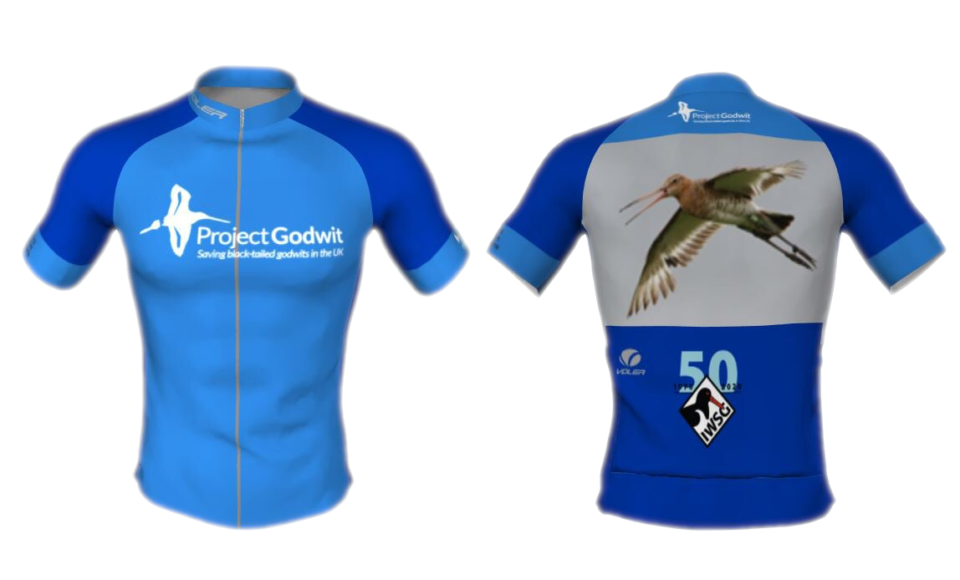 You can purchase it now and until the 27th Jully by sending an email to
You can purchase it now and until the 27th Jully by sending an email to 
 The 2020 IWSG Small Grant will support the project proposal of Emmanuel Nii Attram Taye from the University of Ghana about the behaviour and nesting success of Black-winged stilts in the Densu Delta Ramsar Site in Ghana. ©E. Taye.[/caption]
The Small Project Grant committee would like to thank all who applied for the grant. We were very happy with the high standard of the projects applied for! Thank you all.
Also, please consider applying for the next application round. Announcement of the opening of the call will come via the IWSG website and social media.
Jannik Hansen
on behalf of the Small Project Grant committee
Featured image: Black-winged Stilt, Somme Bay, July 2018, ©Bigayon.
The 2020 IWSG Small Grant will support the project proposal of Emmanuel Nii Attram Taye from the University of Ghana about the behaviour and nesting success of Black-winged stilts in the Densu Delta Ramsar Site in Ghana. ©E. Taye.[/caption]
The Small Project Grant committee would like to thank all who applied for the grant. We were very happy with the high standard of the projects applied for! Thank you all.
Also, please consider applying for the next application round. Announcement of the opening of the call will come via the IWSG website and social media.
Jannik Hansen
on behalf of the Small Project Grant committee
Featured image: Black-winged Stilt, Somme Bay, July 2018, ©Bigayon.  Fieldwork in Africa can be difficult for researchers working with shorebirds, but an engagement with local communities is worth of the investment and represents a key to the successful conservation measures, photo: Vojtěch Kubelka.[/caption]
Featured image: Adult Shore Plover (Thinornis novaeseelandiae), monitored in detail at Motutapu Island, New Zealand, photo: Vojtěch Kubelka.
Fieldwork in Africa can be difficult for researchers working with shorebirds, but an engagement with local communities is worth of the investment and represents a key to the successful conservation measures, photo: Vojtěch Kubelka.[/caption]
Featured image: Adult Shore Plover (Thinornis novaeseelandiae), monitored in detail at Motutapu Island, New Zealand, photo: Vojtěch Kubelka. 

 Sri Lanka is located at the at the southern edge of the Central Asian Flyway.[/caption]
Mannar is undergoing a rapid change. Its wetlands are being encroached and utilized for carelessly planned development activities. A new development scheme of ADB funded wind turbines is coming up – a series of windmills are being erected along the western coast of the island and the associated power lines move right across the Vankalei mudflats - the largest wintering ground in Mannar – which is also a Ramsar site. This was the same site where one individual of the extremely threatened
Sri Lanka is located at the at the southern edge of the Central Asian Flyway.[/caption]
Mannar is undergoing a rapid change. Its wetlands are being encroached and utilized for carelessly planned development activities. A new development scheme of ADB funded wind turbines is coming up – a series of windmills are being erected along the western coast of the island and the associated power lines move right across the Vankalei mudflats - the largest wintering ground in Mannar – which is also a Ramsar site. This was the same site where one individual of the extremely threatened  Spoon-billed Sandpiper at Vankalai Sanctuary in Mannar, Sri Lanka, on 06 June 2018. Darshana, T. W. R., 2018. Rediscovery of the Spoon-billed Sandpiper Calidris pygmaea in Sri Lanka after 40 years. Indian BIRDS. 14 (4): 111–112. © Ravi Darshana.[/caption]
Spoon-billed Sandpiper at Vankalai Sanctuary in Mannar, Sri Lanka, on 06 June 2018. Darshana, T. W. R., 2018. Rediscovery of the Spoon-billed Sandpiper Calidris pygmaea in Sri Lanka after 40 years. Indian BIRDS. 14 (4): 111–112. © Ravi Darshana.[/caption]
 H29 Great Knot photographed by Debunkur Biswas, last week in Mannar. The bird was banded on April 22nd 2014 in Chongming Dongtan, Shanghai, China as an adult. © Debunkur Biswas.[/caption]
The Field Ornithology Group of Sri Lanka (FOGSL), which is the BirdLife partner in Sri Lanka is a conservation organization located at the Department of Zoology, University of Colombo, Sri Lanka. FOGSL runs the National Bird Ringing Programme for Sri Lanka in collaboration with the Department of Wildlife Conservation. FOGSL as part of their banding programme has a research project on shorebird migration in Mannar. We have a banding station and a local field station where graduate students, wildlife officers and general public band and study shorebirds.
So far, we produced 04 banded Great Knots from Mannar. The first 03 birds which were banded in January 2019 were resighted every month since then, till June 2019. They were regularly seen in a flock of ~20 birds. Resightings were made again in October 2019 when a flock of 75 individuals appeared back to the same mudflat. We are planning to deploy GPS tags on some of these birds in the spring before they head north for breeding to track their exact migratory paths and to map the boundary of CAF, from a Sri Lanka standpoint.
Sampath Seneviratne PhD
Research Scientist - Molecular Ecology | Evolution | Ornithology
Department of Zoology & Environment Sciences,
University of Colombo
Website: Avian Evolution Node:
H29 Great Knot photographed by Debunkur Biswas, last week in Mannar. The bird was banded on April 22nd 2014 in Chongming Dongtan, Shanghai, China as an adult. © Debunkur Biswas.[/caption]
The Field Ornithology Group of Sri Lanka (FOGSL), which is the BirdLife partner in Sri Lanka is a conservation organization located at the Department of Zoology, University of Colombo, Sri Lanka. FOGSL runs the National Bird Ringing Programme for Sri Lanka in collaboration with the Department of Wildlife Conservation. FOGSL as part of their banding programme has a research project on shorebird migration in Mannar. We have a banding station and a local field station where graduate students, wildlife officers and general public band and study shorebirds.
So far, we produced 04 banded Great Knots from Mannar. The first 03 birds which were banded in January 2019 were resighted every month since then, till June 2019. They were regularly seen in a flock of ~20 birds. Resightings were made again in October 2019 when a flock of 75 individuals appeared back to the same mudflat. We are planning to deploy GPS tags on some of these birds in the spring before they head north for breeding to track their exact migratory paths and to map the boundary of CAF, from a Sri Lanka standpoint.
Sampath Seneviratne PhD
Research Scientist - Molecular Ecology | Evolution | Ornithology
Department of Zoology & Environment Sciences,
University of Colombo
Website: Avian Evolution Node:  Site location of the Campdown proposed development (top) is identified in the
Site location of the Campdown proposed development (top) is identified in the  Up to 350 Brent Geese and 150 Curlew feed on these wet grassland in the winter, returning to roost in Langstone Harbour each evening.
Peter Potts, a long-time IWSG member, is actively fighting against this housing development project, presenting arguments motived by his many years of experience on surveying waders in the Solent estuary area. See the detailed objection of Pete there:
Up to 350 Brent Geese and 150 Curlew feed on these wet grassland in the winter, returning to roost in Langstone Harbour each evening.
Peter Potts, a long-time IWSG member, is actively fighting against this housing development project, presenting arguments motived by his many years of experience on surveying waders in the Solent estuary area. See the detailed objection of Pete there:  View from the Jinshanyakou Field Station over the mountain ranges of South Yunnan (photo: D.R. Gustafsson).[/caption]
On the other side of the world, and at sea level, Tavera and colleagues set up mist nets on the Pacific coast at the Paracas National Reserve, Perú. They caught birds in September 2017, January 2018 and March 2018 – across seasons – because they wanted to document seasonal patterns of louse abundance.
[caption id="attachment_13360" align="alignnone" width="700"]
View from the Jinshanyakou Field Station over the mountain ranges of South Yunnan (photo: D.R. Gustafsson).[/caption]
On the other side of the world, and at sea level, Tavera and colleagues set up mist nets on the Pacific coast at the Paracas National Reserve, Perú. They caught birds in September 2017, January 2018 and March 2018 – across seasons – because they wanted to document seasonal patterns of louse abundance.
[caption id="attachment_13360" align="alignnone" width="700"] Sanderlings, Western and Semipalmated Sandpipers foraging in Paracas, Perú (photo: E.A. Tavera).[/caption]
The second step was finding and then capturing the lice. In both studies, louse checks were performed immediately after the birds were caught. This is because lice can escape. Some of us have held birds and had their lice crawl right onto us. Of course, finding the lice isn’t always that easy. One way to get to them is to gas them out. Gustafsson and colleagues started with this approach. They placed the birds in bags (with their heads safely uncovered) and fumigated the feathers with ethyl acetate. This got some of the lice, but some remained hidden in the thick plumage. So, the researchers also manually searched for lice on the wings, back, rump, flanks, neck and head, using forceps to lift the feathers. Tavera and colleagues used only manual searching. They also ensured that the same observer examined body and flight feathers from all birds for a set time of 2–3 min. This minimized variation in sampling effort and technique. Once removed from the birds, the lice were stored in ethanol to be taken to the lab.
The final step was identifying what species of louse had been found. In both studies, the researchers first had to prepare the specimens. They used 20% potassium hydroxide (KOH), which softens, digests and clears the tissues, making identification easier. Then they dehydrated the specimens using increasingly stronger solutions of ethanol. Finally, they mounted each specimen on a slide and let it dry further. Only then could the researchers truly examine specimens under a light microscope and use taxonomic keys to identify the lice based on morphology.
Using these careful methods, Gustafsson and colleagues sampled a total of seven Grey-headed Lapwings. Of these, four birds were parasitized by Actornithophilus hoplopteri (nine males, ten females, eight nymphs), and one bird was parasitized by Quadraceps sinensis (six males, three females). The only bird parasitized by Q. sinensis was also parasitized by A. hoplopteri. The samples size is small because the lapwings were caught as part of a larger study on chewing lice in a number of non-shorebird species5. However, only a small sample was needed to achieve the authors’ goal to comprehensively redescribe both the males and females of the two species found. This will provide shorebird researchers with better identification tools to study bird lice in the future.
Tavera and colleagues caught and sampled 108 individuals of seven shorebird species and collected 160 individual lice. The lice were of the Menoponidae and Philopteridae families and the authors were further able to classify them into four genera and nine species. All of the species reported were new geographical records for shorebirds in Perú.
Tavera and colleagues found that lice were most prevalent on Ruddy Turnstones Arenaria interpres and Sanderlings Calidris alba, with 80% of birds parasitized. Western Sandpipers C. mauri were the least parasitized species, with 36% parasitized. Sanderlings hosted the highest abundance of lice, while Semipalmated Sandpipers C. pusilla had the highest species richness hosting four different species of louse.
The authors were interested in whether louse infestations negatively affected body condition, but they found no significant relationship between body condition and total parasites. Infested (or more infested) birds did not seem to have decreased body condition. So just how important are chewing lice in Perú? This study suggests that they may be a mere annoyance at the levels of infestation found.
In terms of seasonality, Tavera and colleagues saw a decreasing trend of parasite number per individual through the nonbreeding season. Although not statistically significant, the trend might indicate that individuals are losing ectoparasites during their stay at Paracas. But why? The authors speculated that the apparent decrease might indicate that habitat in Perú is ‘cleaner’ than the birds’ more northerly stopovers. This would be consistent with the hypothesis that long distance migrating shorebirds might have lower immunocompetence and thus need to use lower parasite marine habitats whenever possible2. However, the apparent reduction of ectoparasite numbers could also indicate that more parasitized birds are leaving the population by emigration or death. A third explanation could be seasonality of the adult versus egg/larval life stages in the lice. Finally, body molt could be a potential reason for reducing a load of ectoparasites, especially in cases where the molt began at arrival to the non-breeding areas.
These two papers contribute to a growing body of knowledge about ectoparasites and their occurrence and effects on birds. Not everyone finds this fascinating, but we need only to look to studies of our own parasites to see the potential6. Humans have been infested by lice for millions of years. Like in birds, human louse infestations can mean everything from annoyance to death. Human body lice can transmit at least three intracellular pathogenic bacteria causing epidemic typhus, relapsing fever, and trench fever. They also have a global distribution – probably because they hitched rides with us as we colonized the globe – and so they can be good markers for studying human evolution.
Lice. Maybe more interesting than you might have thought.
PDF is available for download here:
Sanderlings, Western and Semipalmated Sandpipers foraging in Paracas, Perú (photo: E.A. Tavera).[/caption]
The second step was finding and then capturing the lice. In both studies, louse checks were performed immediately after the birds were caught. This is because lice can escape. Some of us have held birds and had their lice crawl right onto us. Of course, finding the lice isn’t always that easy. One way to get to them is to gas them out. Gustafsson and colleagues started with this approach. They placed the birds in bags (with their heads safely uncovered) and fumigated the feathers with ethyl acetate. This got some of the lice, but some remained hidden in the thick plumage. So, the researchers also manually searched for lice on the wings, back, rump, flanks, neck and head, using forceps to lift the feathers. Tavera and colleagues used only manual searching. They also ensured that the same observer examined body and flight feathers from all birds for a set time of 2–3 min. This minimized variation in sampling effort and technique. Once removed from the birds, the lice were stored in ethanol to be taken to the lab.
The final step was identifying what species of louse had been found. In both studies, the researchers first had to prepare the specimens. They used 20% potassium hydroxide (KOH), which softens, digests and clears the tissues, making identification easier. Then they dehydrated the specimens using increasingly stronger solutions of ethanol. Finally, they mounted each specimen on a slide and let it dry further. Only then could the researchers truly examine specimens under a light microscope and use taxonomic keys to identify the lice based on morphology.
Using these careful methods, Gustafsson and colleagues sampled a total of seven Grey-headed Lapwings. Of these, four birds were parasitized by Actornithophilus hoplopteri (nine males, ten females, eight nymphs), and one bird was parasitized by Quadraceps sinensis (six males, three females). The only bird parasitized by Q. sinensis was also parasitized by A. hoplopteri. The samples size is small because the lapwings were caught as part of a larger study on chewing lice in a number of non-shorebird species5. However, only a small sample was needed to achieve the authors’ goal to comprehensively redescribe both the males and females of the two species found. This will provide shorebird researchers with better identification tools to study bird lice in the future.
Tavera and colleagues caught and sampled 108 individuals of seven shorebird species and collected 160 individual lice. The lice were of the Menoponidae and Philopteridae families and the authors were further able to classify them into four genera and nine species. All of the species reported were new geographical records for shorebirds in Perú.
Tavera and colleagues found that lice were most prevalent on Ruddy Turnstones Arenaria interpres and Sanderlings Calidris alba, with 80% of birds parasitized. Western Sandpipers C. mauri were the least parasitized species, with 36% parasitized. Sanderlings hosted the highest abundance of lice, while Semipalmated Sandpipers C. pusilla had the highest species richness hosting four different species of louse.
The authors were interested in whether louse infestations negatively affected body condition, but they found no significant relationship between body condition and total parasites. Infested (or more infested) birds did not seem to have decreased body condition. So just how important are chewing lice in Perú? This study suggests that they may be a mere annoyance at the levels of infestation found.
In terms of seasonality, Tavera and colleagues saw a decreasing trend of parasite number per individual through the nonbreeding season. Although not statistically significant, the trend might indicate that individuals are losing ectoparasites during their stay at Paracas. But why? The authors speculated that the apparent decrease might indicate that habitat in Perú is ‘cleaner’ than the birds’ more northerly stopovers. This would be consistent with the hypothesis that long distance migrating shorebirds might have lower immunocompetence and thus need to use lower parasite marine habitats whenever possible2. However, the apparent reduction of ectoparasite numbers could also indicate that more parasitized birds are leaving the population by emigration or death. A third explanation could be seasonality of the adult versus egg/larval life stages in the lice. Finally, body molt could be a potential reason for reducing a load of ectoparasites, especially in cases where the molt began at arrival to the non-breeding areas.
These two papers contribute to a growing body of knowledge about ectoparasites and their occurrence and effects on birds. Not everyone finds this fascinating, but we need only to look to studies of our own parasites to see the potential6. Humans have been infested by lice for millions of years. Like in birds, human louse infestations can mean everything from annoyance to death. Human body lice can transmit at least three intracellular pathogenic bacteria causing epidemic typhus, relapsing fever, and trench fever. They also have a global distribution – probably because they hitched rides with us as we colonized the globe – and so they can be good markers for studying human evolution.
Lice. Maybe more interesting than you might have thought.
PDF is available for download here: